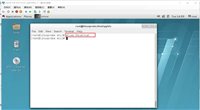操作系统:red hat enterprise linux server release 7.6
001、日常维护常用查询命令
#top 显示系统进程
#clear 清理屏幕信息
#cat /etc/redhat-release 查看系统版本信息
#cat /proc/version 查看系统内核版本等信息
#uname -a 查看系统内核等信息
#cat /proc/cpuinfo 查看cpu信息
#cat /proc/meminfo 查看内存信息
#cat /proc/swaps 查看交换空间信息
#getconf long_bit 查看cpu是32位还是64位
#dmidecode|more 如何查看bios信息等。
#grep memtotal /proc/meminfo 查看物理内存信息
#grep swaptotal /proc/meminfo 查看交换空间的大小
#cat /etc/passwd 查看账户信息
#cat /etc/shadow 查看密码信息
#cat /etc/group 查看都有哪些组,每个组包含哪些用户,或#vigr
#groups username 查看用户属于哪一个组
#ps -aux 显示终端上的所有进程,包括其他用户的进程。
#ps -x 显示没有控制终端的进程。
#ps -e 显示所有进程。
#ps -r 只显示正在运行的进程。
free命令可以查看内存使用率
top -n1命令中有cpu使用率信息
002、修改启动界面为文本模式(命令模式)
3为文本模式,5为图形模式。
#vi /etc/inittab
修改id:5:initdefault:为id:3:initdefault:
003、修改远程管理时命令行下中文乱码问题
red hat enterprise linux默认的语言编码是“zh_cn.utf-8”,在x-window桌面环境下能正常显示汉字,但如果通过ssh或telnet等方式进行远程管理时,就会发现所有的汉字变成乱码了。
#vi /etc/sysconfig/i18n
将lang="zh_cn.utf-8"改为lang="zh_cn.gb18030",重新登录后即可正常显示汉字。
系统默认英文语言:
编辑/etc/sysconfig/i18n
lang="en_us.utf-8"
supported="en_us.utf-8:en_us:en"
sysfont="latarcyrheb-sun16"
系统默认中文语言:
lang="zh_cn.utf-8"
supported="zh_cn.utf-8:zh_cn:zh"
sysfont="latarcyrheb-sun16"
系统默认英文语言,同时支持中文语言:
lang="en_us"
language="en_us"
supported="zh_cn.gb18030:zh_cn:zh:en_us.utf-8:en_us:en"
sysfont="lat0-sun16"
sysfontacm="8859-15"
004、配置网卡相关信息
#cd /etc/sysconfig/network-scripts
#ls
#vi ifcfg-eth0
device=eth0
bootproto=static
broadcast=192.168.0.255
hwaddr=00:17:31:7f:6b:a7
ipaddr=192.168.0.68
netmask=255.255.255.0
network=192.168.0.0
onboot=yes
type=ethernet
:wq退出。
#service network restart 重新启动网络
005、更改主机名
#vi /etc/sysconfig/network
#sudo vi /etc/hostname
将hostname改名,然后重启即可。
006、考虑到安全问题,只允许普通账户直接远程登录,不允许root直接远程登录
配置sshd
启动sshd服务:/etc/init.d/sshd start
编辑/etc/ssh/sshd_config文件,找到语句permitrootlogin yes,将yes修改为no。
重新启动sshd服务:/etc/init.d/sshd restart
007、关闭不需要的系统服务
为了安装的系统执行效能更佳,建议关闭一些没有必要的系统服务,例如cups、sendmail、isdn、smartd、iptables、pcmcia...等。
#chkconfig cups off
#chkconfig sendmail off
#chkconfig isdn off
#chkconfig smartd off
#chkconfig iptables off
#chkconfig pcmcia off
008、修改dns
标准格式:nameserver dns地址
#vi /etc/resolv.conf
nameserver 192.168.0.36
nameserver 202.106.0.20
:wq #保存退出。
#service network restart #重新启动网络
009、查看系统磁盘的分区情况以及文件系统被挂载的位置
#df –h
filesystem size used avail use% mounted on
/dev/hda3 36g 4.1g 30g 12% /
/dev/hda1 190m 8.4m 172m 5% /boot
none 248m 0 248m 0% /dev/shm
#df -h /home 查看home所在分区的磁盘使用情况
010、查看目录及该目录下文件的大小,或查看单个文件的大小
#du -h 目录或文件
[root@eric68 /]# du -h /tmp
12k /tmp/.font-unix
8.0k /tmp/.ice-unix
12k /tmp/ssh-wdiorjg370
36k /tmp/test
164k /tmp
[root@eric68 tmp]# du -h 1.txt
8.0k 1.txt
du -sh 目录或文件 //查看目录或文件的总大小
[root@eric68 /]# du -sh /tmp
164k /tmp
[root@eric68 tmp]# du -sh 1.txt
8.0k 1.txt
011、查看目录权限:ls –ld 目录名
[root@db65 tmp]# ls -ld perl
drwxr-xr-x 2 root root 4096 mar 26 12:39 perl
查看目录下的文件的权限:ls –lr 目录名
[root@db65 tmp]# ls -lr perl
total 24
-rwxr-xr-x 1 root root 24 mar 26 12:39 test2.pl
-rw-r--r-- 1 root root 65 mar 26 12:38 test1.pl
-rw-r--r-- 1 root root 44 mar 26 12:38 helloworld.pl
改变目录的权限:chmod 相应权限 目录名/
改变目录及其子目录和文件权限:chmod –r 相应权限 目录名/
012、获取当前所有登陆者信息
[root@db80 /]# users
root
[root@db80 /]# who
root pts/1 mar 20 11:42 (192.168.0.66)
[root@db80 /]# w
15:34:43 up 3:57, 1 user, load average: 0.00, 0.00, 0.00
user tty from login@ idle jcpu pcpu what
root pts/1 192.168.0.66 11:42 0.00s 0.14s 0.00s w
013、查看系统里有多少个账户
# wc /etc/passwd -l
36 /etc/passwd
014.启动和停止apache服务
#/etc/init.d/httpd start //启动httpd服务
#/etc/init.d/httpd stop //关闭httpd服务
#/etc/init.d/httpd restart //重启httpd服务
自动启动web服务:
如果需要让httpd服务随系统启动而自动加载,可以执行"ntsysv"命令启动服务配置程序,找到"httpd"服务,在其前面加上星号(*),然后选择"确定"即可。
apache的主配置文件是httpd.conf默认路径:/etc/httpd/conf/httpd.conf
015、启动和停止tomcat服务
# /etc/rc.d/init.d/tomcat5 start 启动tomcat服务
# /etc/rc.d/init.d/tomcat5 stop 停止tomcat服务
# /etc/rc.d/init.d/tomcat5 restart 重启omcat服务
自动启动tomcat服务:
如果需要让tomcat服务随系统启动而自动加载,可以执行"ntsysv"命令启动服务配置程序,找到"tomcat5"服务,在其前面加上星号(*),然后选择"确定"即可。
016、iptables防火墙
关闭防火墙:执行“ntsysv”命令启动服务配置程序,取消“iptables”服务前的“*”号。
若开启了防火墙,如何开放tcp协议的80端口:iptables -i input -p tcp --dport 80 -j accept
关掉selinux:
#vi /etc/selinux/config
# this file controls the state of selinux on the system.
# selinux= can take one of these three values:
# enforcing - selinux security policy is enforced.
# permissive - selinux prints warnings instead of enforcing.
# disabled - selinux is fully disabled.
selinux=disabled #这样就把selinux服务器关掉了,请重新启动系统;
# selinuxtype= type of policy in use. possible values are:
# targeted - only targeted network daemons are protected.
# strict - full selinux protection.
selinuxtype=targeted
017、禁止、响应ping
# echo 1 > /proc/sys/net/ipv4/icmp_echo_ignore_all 禁止ping,忽略icmp包。
# echo 0 > /proc/sys/net/ipv4/icmp_echo_ignore_all 响应ping
以上两个设置在重启后失效,若添加到/etc/rc.local里,重启后仍然有效。
018、history
查看历史记录命令:#history
注释:查看以前使用过的命令,默认最大历史记录条数为1000(red hat 中),可以在 "/etc/profile"里面修改"histsize" 参数来修改默认值
清除历史记录命令:#history –c
立即更新history文件命令:#history -w
history记录原理:当一个用户用bash登录系统,他所输入的命令会放到一个内存catch中,在他登出时会存入~/.bash_history中,用histroy -c 命令可以清空这一命令缓存,也就是说,这一用户不想让人知道他做了些什么的话,只要在退出前执行history -c就行了。
查看某个用户的history记录:
#history –w
#history或#more .bash_history
如何自动备份某个用户的history记录?
1.建立ericyi用户的history每日备份脚本
#cd tmp
#mkdir ericyi_history_backup
#chown root ericyi_history_backup/
#vi ericyihistorybackupdaily.sh
-----------------------------------------------------------------
#!/bin/bash
day=`date +%y-%m-%d`
basedir="/tmp/ericyi_history_backup "
cd /home/ericyi
history -w
cp .bash_history "$basedir"/history."$day" > /dev/null
-----------------------------------------------------------------
如何记录用户登陆后的命令操作和系统输出?
在/etc/profile中添加如下内容:
--------------------------------------------------------------------------------
# log user input except test
if [$user != "test" ]; then
sshclientip=`echo $ssh_client | awk '{ print $1; }'`
userlogfilename=/tmp/${user}_`date +"%y%m%d%h%m"`_from_${sshclientip}.log
echo "ssh client info: "${ssh_client} >${userlogfilename}
exec /usr/bin/script -a -f -q ${userlogfilename}
fi
--------------------------------------------------------------------------------
019、linux下定期备份数据
# chmod 700 backupdaily.sh //修改权限,root执行
# vi /etc/crontab //任务计划
#加入下面内容
10 1 * * * root /etc/root/backupdaily.sh
注释:每天1点10分运行脚本
:wq保存退出。
020、linux下定期同步时间
#ntpdate 207.46.232.182
做个脚本,放在crontab中定期执行即可。
本文来自csdn博客,转载请标明出处:http://blog.csdn.net/cocis/archive/2009/04/13/4068367.aspx
如对本文有疑问, 点击进行留言回复!!


linux下文本编辑器vim的使用方法(复制、粘贴、替换、行号、撤销、多文件操作)





网友评论